Monday, 24 June 2013
  Old, applique thangka of Lama Je Tsongkhapa and His 2 spiritual sons
__________________________________________________________________________________________________________________
The King of Dharma, Lama Je Tsongkhapa, told His disciple, Jamyang Choje, "Your founding of Drepung Monastery shall surpass the mother monastery of Ganden and all of Gelugpa's myriad major and branch monasteries in spiritual depth, flourishing and perfection."
True to His words, a disproportionately high number of Ganden Tripas, averaging about double to that of other of Tibet's most renowned monastic colleges, hail from Drepung Loseling Monastery, occupying the Ganden Throne, succeeding Lama Je Tsongkhapa's spiritual throne, acting as the official head of Tibet's largest and most influential school, the Gelugpa Lineage, the school which the Dalai Lamas and the Panchen Lamas are principally affiliated to.
Drepung Monastery continues to be the bulwark of the Dharma in this degenerate age, in addition to being one of the world's most effective teachers and torch-bearer and the most recognisable face of Buddhism, through the "Drepung Lama", His Holiness the Dalai Lama of Tibet.
 The "Drepung Lama" at Vienna, Austria.
_______________________________________________________________________________________________________________
The Dalai Lama calls Himself a "Drepung Lama" as the lineal Dalai Lamas lived, learned and served Drepung Monastery since the time of Lama Tsongkhapa, building His "Ganden Phodrang" or "Palace of Ganden" - the historic Tibetan government in ancient times - in Drepung Monastery itself.
As the late Dudjom Rinpoche wrote, in "The Nyingma School of Tibetan Buddhism" that "The venerable Tsongkhapa vastly increased the enlightened activities of exegesis and attainment ...." and also in numerous texts that the Dalai Lama shall be the critical figure for Tibet and the Dharma in our time.
Both Tsongkhapa's teachings and the Dalai Lama are more than fully expressed through Drepung.
CAS's Root Teachers, the late 100th Ganden Trisur and now, the Abbot Emeritus of Drepung Loseling Monastery, Drepung Loseling Khensur Lobsang Gyamtso, are all from Drepung Loseling and this June, 2 beings @ Phuntsok Cho Ling (CAS), are blessed to have travelled to Drepung Loseling in-exile, in India, to conduct an extensive interview with this extraordinary head of one of Tibet's most prestigious monastic universities.
 The 100th Ganden Trisur -
Official Head of the Gelugpa Tradition
__________________________________________________________________________________________________________________
Therefore, save it, read, learn and rejoice.
bb @ Phuntsok Cho Ling (CAS)
 3,500 monks in front of the prayer hall of Drepung Loseling Monastery, India.
_____________________________________________________________________________________________________________________
Two interviews with
Abbot Emeritus of Drepung Loseling Monastery -
Khensur Lobsang Gyamtso Rinpoche
14 & 16 June 2013, at Drepung Loseling Monastery, Mundgod, Karnataka, India.
Lama Tashi Chophel from Gowo Khamtsen, Drepung Loseling Monastery.
Translated from Chinese to English by Kunga Nyima @ Phuntsok Cho Ling (CAS). _____________________________________________________________________________________________________________________
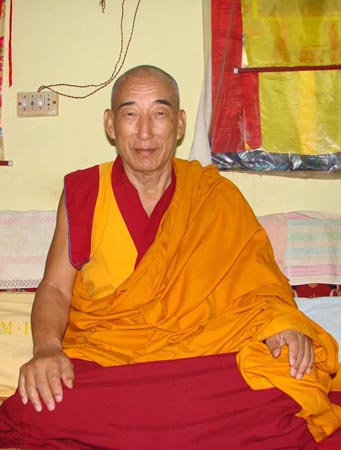 Drepung Loseling Khensur Rinpoche
_______________________________________________________________________________________________________________________
About Khensur Rinpoche
Early life
R: The interview has not even started and you have already thanked me. What will you do when the interview is over ?? ( Rinpoche laughs )
When are you born ??
1933.
Who are your parents ??
My father is called Sonam Tsering and my mother's name is Yeshe Lhamo. I am born in Batang province, Zhom Zha region and the place is called Mi Zu Zang.
What are your parents' occupation.
They are farmers.
How many siblings do you have ??
6 siblings. 3 boys and 3 sisters. I am the youngest.
When were you ordained ??
I was ordained at 3 years old.
Were you ordained at the local monastery ??
I was ordained in 1935 at Zinzik Dechen Cho Ling monastery.
Did you yourself decide to ordain ??
When I was 2 or 3 years old, I was seriously ill. My parents consulted a Lama for prediction. The Lama's prediction was that I will live long if I was ordained. However, if I am remain a householder, I will die early. So, my parents decided that I should get ordained.
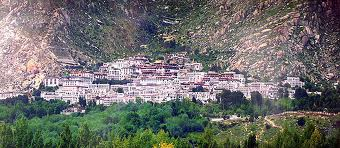 Drepung, Tibet
______________________________________________________________________________________________________________
How then later did you decide to enter Drepung Monastery ??
From 3 to 18 years of age, I stayed at the monastery at Batang. Later, we wanted to go to Lhasa to obtain the Gelong vows. At that time, many monks wanted to travel to Lhasa to obtain the full ordination. In the past, when you had reached 18 years old, unless you are blind or handicapped, otherwise, when you reached 18 years, you would need to travel to the 3 Great Monasteries to further your studies. When I reached Drepung Loseling Gowo Khamtsen in Tibet, I continued staying on for the next 7 years and 8 months. In 1959, due to China's invasion of Tibet, we all had to escape to India. If we had not escaped, we would have died or been imprisoned for long. We would have become unhealthy, and would have then died. We are Khampas. We heard that Khampas who were caught were imprisoned, poisoned due to bad food or deliberately poisoned. In 1959, I heard that 1.2 million Tibetans died as a result of the invasion.
At Dechen Cho Ling, what did you learn ??
From 3 to 18 years, I mostly learned tantric practices: Yamantaka, Chakrasamvara and Guhyasamaja. In total, I had 3 teachers: Tsultrim Palden, Kelsang Tsering and Losang Gonpo. I learned a lot, a lot of tantric practices of Yidams there. I only learnt a bit on debate and sutra. There are 1,100 monks in the monastery. It is a very good monastery.
At 18 years, do the monks have to travel only to Drepung or could they travel too to other monasteries like Sera ??
Monks from the monastery came from 15 different areas. Monks from 5 out of the 15 areas, could travel to any of the 3 Great Monasteries. Monks from the remaining 10 areas could only go to either Ganden or Drepung monasteries. When these monks first went to Lhasa, no one would have first decided whether they would go to Ganden or Drepung. At that time, the Manager of Gowo Khamtsen from Drepung Loseling met us when we first reached Lhasa. We drew lots and it was then decided where we would go to although we were all from the same monastery back home.
Any monks went to Sera ??
From our monastery at Batang, monks also go to Sera, Lha Khamtsen.
How was life like in Drepung Loseling Gowo Khamtsen in Tibet ??
Compared to our lives presently, we were then all extremely, extremely impoverished. Monks all have to eat tsampa, ground them into powder form. We drank black tea without butter, or in extremely small quantity. If there were sponsors for puja at Drepung Loseling, they would offer tsampa or black tea. Otherwise, there was nothing. 3 meals a day, it was all tsampa. The relatively wealthier monks would add in a bit of butter in their tsampa.
Meals were provided by the monastery or the monks themselves had to look for them ??
The respective khamtsens and the monastery gave the monks rations of raw tsampa 6 times per year. Every time, 6 "jins" are given. The monks had to grind the raw tsampa into powder form.
Did the monastery provide tea ??
During studies, there would be tea provided. There were 3 classes of 20 days in a year; 4 classes of one month in a year; 2 classes of 15 days in a year. During these periods of study, tea would be provided. Every day, 9 am to 11 am, meals are provided. Other times of the day, no food was given. When there were pujas, tea was provided. No pujas, no tea would be provided.
Were these rations sufficient ??
Definitely not enough. When there were offerings from sponsors during pujas, or when our parents sent us tsampas from our home town, all these just were able to meet our needs. When we did pujas outside the monastery, then we could also obtain some offerings.
Rinpoche left in 1959. How did Rinpoche escape and how many people escaped with Rinpoche ??
I walked out of Tibet. We carried our own food. About 90 over people escaped together.
Did all escape safely ??
Only 56 people managed to escape. The rest were killed or caught by the Chinese army. Others simply disappeared.
Why did Rinpoche decide to escape ??
We heard news that His Holiness had left Tibet. We thought therefore also that we would not be able to continue staying in Tibet with His Holiness gone. Also, at Norbu Lingka, His Holiness's Summer Palace was bombed and armies shelled it with big canons. We saw this and we decided to leave. We had no plans to leave for India. We only knew to run. We had no proper plans where to run. We simply ran and ran and in the end we found ourselves in India. We heard that the Tibetan resistance fighters had brought His Holiness to India and so we inquired from them how to get to India and following their directions, we also arrived in India.
Refugee in India
Where was where you first arrived at in India ??
The first place was at Arunachal Pradesh, where the first Gyuto Monastery was established.
Who were your teachers at Lhasa Drepung ??
My Teacher was the previous Geshe Woeser, now Woeser Rinpoche. Also, there was Geshe Lhakyab, now reincarnated as Lhakyab Rinpoche with us in Loseling in India. In India, my teachers were Khensur Pema Gyaltshen and Gen Nyima Gyaltshen.
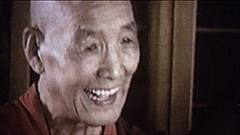 Rinpoche's Teacher, Khensur Pema Gyaltshen
__________________________________________________________________________________________________________________
Are the studies same as in Tibet ??
They are the same. Loseling studies the works of Lama Tsongkhapa and His 2 spiritual sons in addition to works of Panchen Sonam Dragpa.
Are there any differences in the learning and practice in Tibet and now in India ??
It is generally the same. We had to study, practise and do debates. We had to travel for the Winter Debate at each of the 3 Great Seats every year. Each of the 3 great monasteries takes turns hosting the Winter Debate every year. Generally speaking, there are advantages in Tibet then and now in India. In Tibet, the standards of Teachers and students were extremely high. But, then, many of them did not learn writing and so could not write well. In certain respects, in India now, students can write and study better. About Geshe standards, the highest Geshe graduate now is only equivalent to a middle standard Geshe graduate then.
Why is there a difference in standard ??
It is due to karma. In Tibet then, students and Geshes have greater merit and are especially inteliigent. The students now have lesser merit and are not as intelligent. These are the reasons. Did Rinpoche's 2 teachers escaped to India ??
Geshe Lhakyab escaped to India.
Did He escape with Rinpoche ??
No, he escaped via Bhutan. Geshe Lhakyab only obtained His Geshe degree in India where he emerged first amongst the 3 great monasteries' candidates. He then proceeded to Dharamsala for retreat. He passed away at Dharamsala.
From Arunachal, where did Rinpoche go to ??
We went to Assam from Arunachal. We had to walk more than 10 days. Along the way, we slept on the road. We left in groups and the Indian government dropped supplies of food from the air, looking for us wherever we had walked to along the way to Assam. From Assam, we went to Buxa where we stayed for 10 years. Like at Tibet, Drepung, we had to study and do debates. After 10 years at Buxa, the Indian government did not provide us with any more supplies and in 1970, we had to move to south India.
What is the reason the food support stopped from the Indian government ??
We had been receiving support from the UN and India. They said we had not done anything for 10 years to deserve continued assistance. To continue receiving food, we had to work and from their perspective, monastic studies and practices do not validate as "work". India itself has a huge population and widespread poverty. Ordinary Indians feel that the Indian government should help them instead of continuing to provide for the Tibetan refugees. Hence, they protested against continued aid.
How old was Rinpoche when you escaped from Tibet ??
I was 23 or 24 years old.
First among the 3 Great Seats of Learning
Rinpoche received His Geshe degree in India at Buxa ??
It was in south India when i was 46 years old. In total, in Drepung in Tibet and in India, I studied for 29 years.
What was Rinpoche's position ??
I received first position amongst the highest Geshe Lharampa degree candidates, amongst the 3 Great Seats of Learning. The second position was won by Tobden Rinpoche, now the Abbot of Drepung Loseling. The third position was won by one Geshe from Sera Je. He has now passed away.
How did you feel then ??
In the past, it was extraordinarily hard. Economic wise, circumstance wise, all were difficult. Food was difficult to obtain, studies textbooks all were difficult to obtain. Now, things are so much better. All conditions are so much better now. You only have to study hard and well now without having to worry about food and others.
How was the Geshe Lharampa studies like ??
We had to travel to all 3 monasteries for debate and it spanned from 5 pm to 9:30 pm. We had to answer one-to-one, not relying on partners to answer for oneself. Our writing manuscript was bad as we had not learnt writing much in the past. But for Lharampas, we had to excel in writing too. The Geshe Lharamapa degree was awarded by His Holiness Himself. His Holiness thanked us for studying well upon completion of our studies. His Holiness spoke of sad matters and we all wept.
What did His Holiness say ??
He said we had not been able to continue with studies in Tibet but even in India we had studied well. When we had our examination, His Holiness was present, Ling Rinpoche was present. His Holiness gave us advice and Ling Rinpoche handed to us our Geshe degree as He was the Ganden Tripa at that time. Now, so many presents are given upon Geshe degree graduation. At that time, our only presents are from His Holiness and they are 2 tantric textbooks. His Holiness told us that now that we had obtained our Geshe degree, we would need to go to either Gyudmey or Gyuto Tantric colleges to continue with tantric studies.
Did Rinpoche proceed to Gyudmey Tantric College ??
I had completed the application form for matriculation into Gyudmey Tantric College. But I was a new Geshe from Drepung Loseling and at that time, Loseling had a branch monastery in Nepal. It was looking for a resident teacher. The monastery ordered me to proceed to Nepal to be resident teacher. Tantric studies was considered my personal pursue whereas the teaching position was an official directive from the monastic administration. Hence, I had to drop my plans for studies at Gyudmey and I went to Nepal to teach for 4 years. The place was Tru-du Monastery, a Loseling branch monastery.
Where did Rinpoche go to after the 4 years ??
While at Nepal, the university at Varanasi was looking for teachers. But to be a teacher there, one had to undergo examination. So I took the examination and passed. I looked for the position myself.
Who tested Rinpoche there ??
Shartse Zemey Rinpoche, Sera Je Khensur Lekden and Upa Dewa. After I passed the examination to be a teacher at Varanasi University, I taught there for 15 years. At the beginning, I could only teach Gelugpa students. Later on, I took an examination which would qualify me to teach students from the 4 Tibetan schools. I passed and I could then teach students from all the 4 Tibetan Buddhist schools.
What did Rinpoche teach there ??
There are no sect-specific works when I taught students of the 4 lineages, no works of Lama Tsongkhapa and the like. Rather, I taught works of the great Nalanda Indian masters like Nagarjuna's works and the such.
How did Rinpoche feel being teacher at Varanasi ??
Time passed very fast at Varanasi. The weather at Varanasi is strange. It is very cold in winter but very hot in summer. All students at Varanasi liked me very much and even the school attendants all appreciated me very much. If students like the teacher, studies become happier and easier for both students and teachers. It was a very happy time for me. 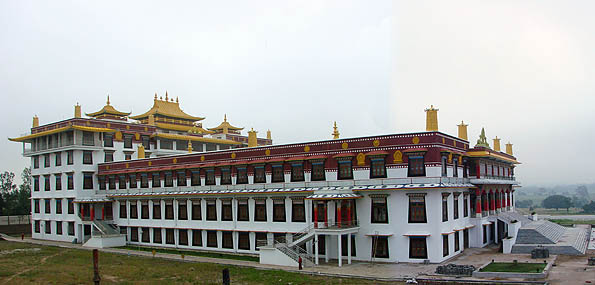 View of Loseling Hall
__________________________________________________________________________________________________________________
The great Abbot
Where did Rinpoce go after 15 years at Varanasi ??
While at Varanasi, I had reached the retirement age of 60. But students petitioned the Tibetan government in-exile requesting that I continued teaching for another 10 more years. However, upon the orders of His Holiness, I was appointed to assume the position of the Abbot of Drepung Loseling and so I had no choice but to leave Varanasi for Drepung.
Who nominated Rinpoche to His Holiness ??
Before myself was another Abbot who wanted to retire. So in Loseling, there was voting and I emerged as the candidate with the highest vote. There were altogether 10 proposed candidates for Abbot of Drepung Loseling. When this list was proposed to His Holiness, His Holiness affirmed me as the most suitable candidate to be the Abbot of Drepung Loseling.
So Rinpoche assumed Abbotship at 70 years of age ??
No, 62 years. I could retire at Varanasi at 60 but upon students' request, I agreed to stay on for 10 more years but before the 10 years was up, I was appointed the Abbot of Drepung Loseling when I was 62.
How did Rinpoche feel when you were appointed to be the Abbot by His Holiness ??
When I received the news, I wasn't particularly happy but felt sad as I liked Varanasi very much. There was nothing to be done. His Holiness has already arranged for the appointment. Even if you are not happy, you dare not approach His Holiness to be excused. When I became the Abbot, the pressure was huge. There was no medical centre, the living conditions and financial situation were all quite challenging at that time when I first assumed Drepung Loseling Abbotship. The monks were numerous but things were not stable. Hence, I had much pressure when I received the appointment and so I was not very happy. Later, though, due to sponsors, well-wishers' help and prayers, things gradually become better. Things are now more stable.
Does His Holiness know Rinpoche personally before appointment as Abbot ??
Before I became Abbot, His Holiness does not know me personally. Every time I met His Holiness, it was always in a group audience. His Holiness probably decided on me as Abbot after "MO", divination. At that time, there was one prominent Geshe, Yeshe Thapkay. He was Loseling's very famous Geshe. The Gaden Tripa now, Rizong Rinpoche, was then the Jangtse Choje. He knew His Holiness very well and proposed Yeshe Thapkay as the Abbot. His Holiness however replied that the best choice according to His divination was "Lobsang Gyamtso" ( Rinpoche's name ). Hence, no one dared to make any other proposals. As there are great pressures and demands being the Abbot, I wanted to approach His Holiness to excuse me from the appointment. Then, Samdhong Rinpoche, the first elected Tibetan Prime Minister, told me to just assume the position and to forget about asking for excuse from His Holiness. Samdhong Rinpoche was also from Varanasi and he liked Varanasi much too. However, he said His Holiness would remember me as the man who refused His appointment whenever His Holiness sees me in the future. Hence, Samdhong Rinpoche advised that I should simply adopt Abbotship. I think therefore also too that I should simply accept.
Was Rizong Rinpoche the only person who proposed Geshe Yeshe Thapkay ??
No, there were some others who proposed Geshe Yeshe Thapkay and planned to bring him directly from Varanasi to Loseling to teach and be Abbot. He was the most famous and prominent Teacher even in Tibet. They all felt that I had many plans of my own whereas Yeshe Thapkay should be brought directly to Loseling from Varanasi, make him the Abbot, then get him to stay to teach here. His teaching is great, his training is excellent. Many approached His Holiness and proposed for Geshe la to become the Abbot. His Holiness while at Gyudmey Tantric College replied to their proposals, "You yourselves should first confirm if Geshe la would or would not accept the appointment. If He accepts Abbotship, I am agreeable to appointing Him as the new Abbot of Drepung Loseling." Hence, Geshe Palden Drakpa and Loseling representatives approached Geshe Yeshe Thapkay, "Would you please be our Abbot ?? We have approached His Holiness and His Holiness had replied that if you agree, you will receive His appointment." Geshe la answered, "Did His Holiness say so ?? In that case, this imply that I could either agree or decline. So, His Holiness has given me permission to make my own decision. Therefore, I have decided not to accept Abbotship." Geshe la directly flew to see His Holiness to request to be excused from Abbotship. His Holiness then told him that it was really not Him but rather the administrators of Loseling who had requested Him to appoint Geshe la as the Abbot.
So, what happened to Geshe la now ??
He is still at Varanasi. He had stayed there. Geshe la is an extremely distinguished teacher but he does not like duties of Abbotship.
How is life like for an Abbot and what are Rinpoche's achievements ??
It is very busy and carries great responsibility. Not a day passed by idle and I have to think of means and ways to help the students. Now, even without external support, the monks could continue in their studies without great worries of financial burden. The monks' standard of study has been raised far higher than before and the new prayer hall has been erected. I had to work with the monastic administrators and to personally make requests to sponsors and well-wishers to support the monastery and through their kindness, the new hall was successfully established. I was able to set-up the medical centre too to provide free health care to all the monks. These are the 3 matters I have been to accomplish and I am happy and satisfied with them. Upon my retirement, I would think that Loseling has become free from major difficulties.
What is Rinpoche's daily life, as an Abbot of one of Tibet's greatest monasteries, like ??
I wake up at 5 am. I will then do my practices till about 7 am. I take my breakfast from about 7am to 8 am. Then, I will start teaching from 8 am to 9 am. From 9 am, if there are meetings I will need to attend. Otherwise, I will continue with whatever practices I could not finish earlier on in the morning. Also, sometimes I will read the texts and commentaries. After these, I will take an afternoon nap till about 2 pm. If I do not sleep, I may feel tired and not have enough energy to take the afternoon classes. There are 3 classes in a day. The first class is from 8 am to 9 am. Then, the second class is from 2 pm to 3 pm, and the third class is from 3 to 4 pm. Sometimes, there are meetings at Dharamsala, at Ganden and other venues and I will be away. It is quite busy being an Abbot. After 4 pm, I will take a light meal, take baths. At 6 pm, the monastery will make prayers. Sometimes, I will make circumambulation of the monastery. Circumambulations are also forms of exercises. From 9 to 11 pm, the monastery will begin the debate session and I will sometimes make inspection-rounds. Whatever extra time I have, I read texts and study. I have rather heavy daily commitments in my practices to fulfill, hence, whatever practices I have not been able to complete, I will also do them during my free time. How many students does Rinpoche have ??
About 500. There are 12 levels of studies, 62 classes and I have different numbers of students in each of the classes.
At meetings, what is being discussed ??
Sometimes, there are directives to have meetings. Sometimes, we discuss about debates, how to improve the studies in the monasteries, the exam matters involving the 3 seats, the exams of the Geshe Lharampas. If there are big pujas in the monasteries, how to enforce discipline and the such. There is a one month great debate session, the financial matters, the lodging of the visting monks and so forth. All these require meetings.
The decision to construct the new prayer hall, to set-up the medical centre, during the exam, to refine the processes.
How is life different as an Abbot emeritus ??
Life is more relaxed now. I have handed over responsibility to the new Abbot. Now, I do practices, contemplate and teach. When I was Abbot, I had to fulfill and implement His Holiness's wishes in the monasteries, whether major or minor issues. Whatever mistakes committed, the blame is laid on the Abbot. Whatever good done, nobody attributes it to the Abbot. The responsibility is huge. We Tibetans have no strong political powers but we do still have much Dharma. The complete spectrum of Dharma exists within the 3 Great Seats of Learning. There are many Sangha members specialising in different aspects and areas of the Dharma in the 3 great monasteries. If the 3 monasteries are destroyed, we can say that the Dharma will be critically if not fatally impacted. So, the responsibility of the Abbots of all the 3 Great Monasteries, Drepung, Sera and Ganden, is extremely huge, not least of all, also because they deputise and act to fulfil the holy aspirations of one person, His Holiness the Dalai Lama. If the 3 monasteries are destroyed, we can even say that the complete spectrum of Dharma will extinguish with them. All 3 levels of Geshes graduate from the 3 Great Monasteries. Without the 3 Great Monasteries, there will be no Geshes. Without the 3 Great Monasteries, slowly and gradually, the Dharma will die out with them. The Abbots are responsible for survival of these Great Monasteries. So, their responsibilites are huge. Before appointment as Abbots, His Holiness will personally make observations via divinations or consult protectors such as Nechung. If we do not carry out our duties well or not acting according to the wishes of His Holiness, or if we are not able to impose good discipline in the monasteries, just sitting there not carrying out our duties well, although no one will penalise, one has to bear the heavy karmic debts !
What is life as an Abbot Emeritus like ??
There are about 2 classes a day. Past years, there are 3 classes. This is near the exam period, so students are revising their studies rather than coming for classes.
Are there any differences in practices for an Abbot Emeritus ??
I do many, many practices everyday like what I mentioned earlier. The practices are a lot and I do the visualisation-meditations together with the recitation of the sadhanas. If I do them slowly, it takes 3 to 4 hours per day. If I do them fast, I can complete in 1 to 2 hours.
What time does Rinpoce retire for the night ??
I sleep at about 10 pm and wake up at about 5 am. As an abbot, I sometimes sleep only after 11 pm or 1 or 2 am as there are many matters to attend to. Through what methods did Rinpoche utilise to raise the standards of studies and how did Rinpoche know that the standards have been raised ??
The best method is to strictly enforce assessment and examination standards and protocol. I borrowed some assessment methods from Varanasi. If you fail, you cannot proceed to the next level. If you continuously fail, you cannot continue to stay on in Loseling. Also, to allow the monks to concentrate on their studies. For example, during construction of the great hall, no one monk was deployed to help to build it. The contruction was entirely given to the external contractors. His Holiness came to Drepung Lachi some years back, all the Abbots of the 3 Great Seats were there during the audience. His Holiness asked, "How was the examination like at Loseling ??" I explained to His Holiness and informed Him that we retain students who do not perform well in their examinations. They are allowed re-examination twice. After the second examination, if they still fail, they have to leave Loseling. His Holiness was very glad and told the other Abbots that if they adopt the same methods, their own respective colleges' standards would similarly improve.
Are there any other methods ??
Another very important method is to enforce strict discipline. There are strict schedules and learning protocols to follow, such as the timing allowed for debates, studies and the like. For debates, the maximum number of debators are 2, one debater to one debater, not 3 or more. Discipline is most important.
Are there any more methods ??
The teachers' standards are very important. There are stipulated guidelines for the teachers to follow in their teaching. Students are also expected to learn conscientiously, to take refuge and learn properly and well from their teachers.
How will we know that standards of learning have truly been raised ??
Rinpoche said that he felt that studies have gradually become better because the monks have more time for studies and not need to work for the monastery. In the past, in the 1960s and 70s, monks need to work for the monastery in many duties but now they can concentrate on their studies. Hence, the studies have become better.
To some extent, yes, but it will take time. Loseling's strict enforcement of discipline is traditionally imposed from long time back in the past. Before examinations can be done well, discipline must be well imposed. Why is the discipline well enforced in Loseling ?? It is all due to the late Khensur Pema Gyaltshen's blessings and work.
So have the other monasteries adopted the same examination procedures ??
I heard that they have.
Tantra
What retreats have Rinpoche completed ??
Solitary Vajrabhairava, 13 deity Vajrabhairava, Chakrasamvara, Guhyasamaja, Vajrayogini Naro Kachodma, Cittamani Tara, Palden Lhamo, Mahakala as well as many minor retreats like Manjushri, Vajrasattva.
Has Rinpoche achieved any realisations or auspicious signs such as through dreams ??
I have achieved none of them.
Who are Rinpoche's initation masters ??
The most important one is His Holiness Himself, Trijang Rinpoche, Ling Rinpoche, Song Rinpoche, Denma Locho Rinpoche, Khenchen Pema Gyaltshen. My most important initiation Lama is His Holiness Himself from whom I received the initiations of Guhyasamaja, Vajrabhairava, Heruka and other important Yidams. I received Lama Chopa, Naro Kachodma from Denma Locho Rinpoche.
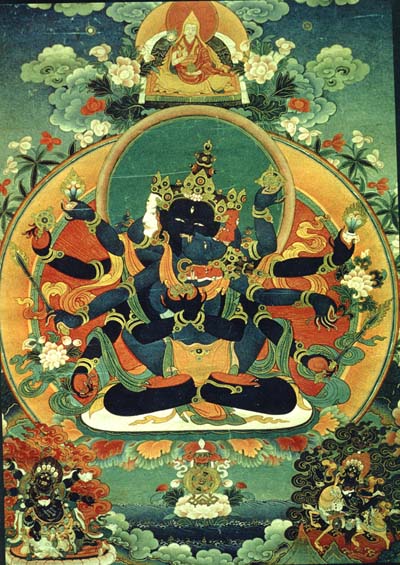 Guhyasamaja, Mahakala and Palden Lhamo
_________________________________________________________________________________________________________
What are Rinpoche's daily commitment practices ??
I have many daily commitments: Solitary Vajrabhairava - long sadhana, Guhyasamaja - middle-length sadhana, Chakrasamvara Body Mandala - middle-length sadhana, Vajrayogini Naro Kachodma, Cittamani Tara - short sadhana, Lama Chopa and "Ten-dru" - 3 times each in the morning, afternoon and night; late evening 3 times again; similar to Guru Yoga practices. Usually, we will keep our practices secret and not tell others. Benediction
Does Rinpoche have any regrets in his life ??
I do not have any regrets. I have not done anything drastically wrong and so have no cause for regret. What are Rinpoche's most diffiult times ??
For learners, studies are most important. At Tibet - Drepung and Buxa, circumstances for studying then were very difficult. I had contracted tuberculosis and at old age, I contracted diabetes.
Does Rinpoche have any hopes for the future ??
No special hopes. The biggest hope is to attain Buddhahood and at death, no obstacles.
What is Rinpoche's happiest time ??
My happiest time is that I have managed to overcome all the problems which I have been worrying about since I have been appointed Abbotship by His Holiness and that I have not met with overwhelming obstacles during the course of my serving as Abbot. Another memorably happy time is that upon my retirement from Abbotship, when I had an audience with His Holiness, I told His Holiness that after 8 years of serving as Abbot, if I had done anything not appropriate or had displeased him, I sincerely offer my heartfelt confessions. His Holiness replied, "You have not done anything wrong. You have in fact done very well, exceedingly well. With regard to the monks' studies, the issue of shugden worship, the finances required to support the monastic community, all of these you have done and accomplished very well. I want to thank you. Now, don't worry about anything. You take a good rest." His Holiness had placed His hands on my shoulders then. At that time, I was overjoyed. I then mentioned to His Holiness that I would like to do a 3 years' retreat. His Holiness said He would not want to give me His permission to do so. Instead, He said that I should teach.
We understand that His Holiness had mentioned that because Rinpoches' teachers had never been involved in shugden worship, therefore His teachers' lineage is "supreme" or the "best". Is this true ??
What happened is that during His Holiness's visit to Drepung, all the Abbots of the 3 Great Seats were present. We were discussing about shugden. I mentioned that once I was serving and studying under the late Loseling Khensur Pema Gyaltshen. Trijang Rinpoche was also one of my teachers. However, during one of the events which was conducted by the late Trijang Rinpoche, I had wanted to participate in it. I had then not known that the event involved shugden. However, I was recalled by Khensur Pema Gyaltshen. He said that I should not attend that day's programme although I could attend all the other events conducted by Trijang Rinpoche. The reason given was that that particular event was specifically associated with shugden. I related this event to His Holiness to inform His Holiness that I personally have never had any links to shugden because my personal teacher had clearly forbidden me from any association to shugden. From the past, presently and the future, I have never had and will never have any links to shugden. His Holiness had then replied, "You are student of an excellent Teacher. You should likewise teach your disciples in the same way. How your teacher has taught, you should also teach likewise."
We heard also that Rinpoche was one of the few recent Loseling Abbots who had fully served out His Abbotship of Drepung Loseling. Is this true ??
Drepung / Gelugpa
Facade of Drepung Loseling Monastery
_______________________________________________________________________________________________________________
How is Drepung different from the other monasteries ??
All the 3 Great Monasteries are of the Gelugpa tradition and we follow Lama Tsongkhapa's teachings. They are very similar. The monastic textbooks all teach for liberation from samsara. There are some differences in nominal monastic protocols. We all study the Lam Rim. There are no major differences.Geshes graduate from the 3 Great Monasteries and their Abbots are all chosen from them. The discipline from the 3 Great Monasteries is excellent and so Geshes from them are also of excellent standards. The chanting tunes though are slightly different.
I understand that Ganden Shartse and Drepung Loseling monasteries use the commentaries written by the Great Pandita or Panchen, Sonam Dragpa. Why do they use his commentaries as monastic textbooks ??
His commentaries are succinct and contain less words but include all salient points and are easily comprehensible. Panchen Sonam Dragpa has penetrative insight into both sutra and tantra. Gyuto also uses commentaries on tantra by Panchen Sonam Dragpa. He is a follower of the Kadampa tradition and his incarnate lineage preceded that of Lama Tsongkhapa but He has incarnated as 3 Ganden Tripas after Lama Tsongkhapa, as Abbots of Gyuto, Drepung and Sera. Before him, Drepung follows the commentaries by Galo but they contain certain unclear points. Panchen Sonam Dragpa clarifies these unclear points and Loseling now follows his writings. He has no present incarnation and he has completely stopped samsaric rebirths.
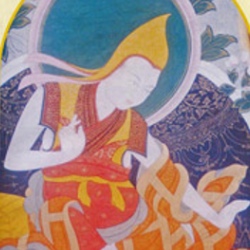 Panchen Sonam Dragpa
_____________________________________________________________________________________________________________________
How is the Gelugpa lineage different from other traditions ??
All traditions are the same. Their practices all lead to liberation, their pathways all lead to the same destination. Some roads are longer, others more direct. All traditions have to understand Emptiness, Bodhicitta, the 4 Noble Truths, Refuge. All traditions involve these points. Any which does not involve these points, will not bring liberation. Guru Padmasambhava has presented the tantric path a bit differently as it is more suitable to certain students. Besides this, all the other points I mentioned are shared in common amongst the 4 Tibetan traditions. Some retreatants participate in the "3 years - 3 months - 3 days" retreat. However, without involving the 3 Principle Aspects of the Path: Renunciation-Bodhicitta-Emptiness, any retreat become meaningless. Some retreatants claim they have mastered these 3 principle aspects after their retreat. But nobody knows if their claims are true. Guru Padmasambhava has attained the highest attainment and is an emanation of Chenrezig. So even though he may partake of alcohol and has consorts, he is enacting inconceivable acts of an enlightened being. Some "practitioners" these days also claim to be able to do the same. One takes consorts in one's tantric path only after one has reached the requisite highest levels. Some "practitioners" claim they could also do so and after taking consorts, they declare their own offsprings, without recognition from their lineages' leaders, also as incarnated "Rinpoches". These are strictly forbidden in the Gelugpa tradition. I have heard of a remote village "lama" in Tibet marrying then having 2 children. He subsequently declared both his sons as high incarnations of great Bodhisattvas. In the Gelugpa tradition, only masters with the highest attainments such as the Dalai Lama or the Ganden Tripa could recognise incarnate masters. For example, we sometimes make requests to the Dalai Lama to find the incarnation of certain masters. If His Holiness is not contactable, we will approach the Ganden Tripa. They will then make divination and do other observations to find the incarnate master.
shugden
Some questions regarding the shugden issue. His Holiness has praised the late Trijang Rinpoche very highly, saying He is a very great practitioner of Chakrasamvara and of the Lam Rim. Trijang Rinpoche is also His Holiness's Junior Tutor. Then, again, His Holiness has pointed out that Trijang Rinpoche's reliance on shugden is a mistake. In many peoples' minds, "How could such a saintly, great master make such a mistake ??"
It is important to note that Trijang Rinpoche did not initiate the shugden reliance but rather it was Takpu Rinpoche who started relying on shugden as a protector. Pabongka Rinpoche followed Takpu Rinpoche, his teacher. Trijang Rinpoche faithfully follows Pabongka Rinpoche, His teacher.
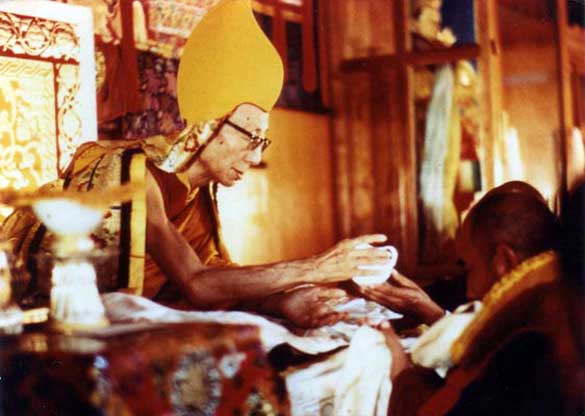 The saintly Trijang Rinpoche
_____________________________________________________________________________________________________________
How could Takpu Rinpoche have make such a mistake ?? Is he an authentic master ??
Kyabje Pabongka has attained the Lam Rim path but obstacles arose during the course of His Dharma practice. This appears in the aspect of His adopting shugden as a protector. However, towards the latter part of His life, Pabongka Rinpoche Himself also gave up relying on shugden as a protector. ( *Interviewer's note: Pabongka Rinpoche's letter on his commitment to the 13th Dalai Lama to retract from relying on shugden is available in http://www.dalailama.com/ ). Trijang Rinpoche at Ganden has also mentioned before that it is not good for the communities in the great monasteries to rely on shugden. He said that relying on shugden as a protector is his personal choice but it is not good for reliance on shugden to widely spread amongst the monastic colleges. Takpu Rinpoche Himself is an indescribable, inconceivable master. Relying on shugden brings him much worldly success but this reliance harms him in all subsequent lives. Shugden helps him only for one life but is detrimental to him in all future lives. For example, during our Dharma practice, some powerful beings approach us to offer us help in wealth and other worldly matters. In ignorance, we accept the help and rely on it. Takpu Rinpoche has yet to attain Enlightenment at that time and during the course of his Dharma practice, shugden approached and offered his help and Takpu Rinpoche accepted. However, shugden brings temporary benefit but harms in the long run and as we can see, many of these great masters all gave up shugden in the end.
You see, for tantric practitioners, we need to see our Gurus as Buddhas. How could we then even consider our gurus to have made mistakes ??
Highly attained masters like His Holiness could perceive the long term detrimental effects of relying on shugden. In the past, many in Sera and Ganden monasteries all rely on shugden as a protector and if not for His Holiness, we will not be able to understand the negative effects of shugden and the details are clear to highly-attained masters like His Holiness. If not for His Holiness, this mistake will be perpetuated. In Drepung where Nechung is our protector, anyone who practises shugden will incur the displeasure of Nechung. This is certain. Hence, in Drepung, no one relies or practises shguden. Nechung disapproves of shugden practice. As ordinary beings, we could only rely on and trust His Holiness's advice to stop shugden and not to rely on or practise it. Actually, even His Holiness has relied on shugden early on in his life. When he was escaping from Tibet, he had practised shugden. But shugden seems to be a spirit from other lands such as China. Shugden has rendered help many times to the invading Chinese army. Shugden has mis-advised a few times and nearly led to disasters many Tibetan people including His Holiness. He initially helped His Holiness but later on he tried to harm His Holiness. This is what His Holiness had said before. Many Abbots in the 3 Great Seats have had this obstacle so you should all investigate very carefully.
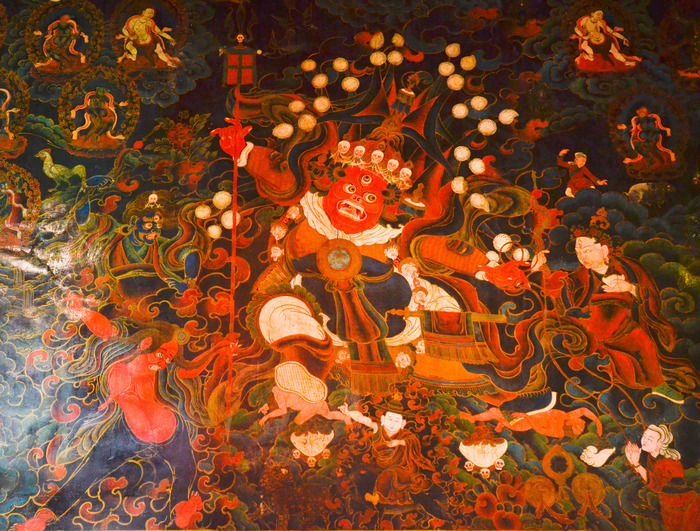 The protector Nechung
_________________________________________________________________________________________________________________
It has been suggested that the Gelugpa lineage has become broken since even the lineage masters could have made mistakes. What does Rinpoche feel about this ??
The lineage is not broken because whether or not one relies on shugden, the Dharma that is taught comes from the Buddha Himself and is pure. The aspect of relying on shugden becomes somewhat irrelevant because these masters had taught truly and purely the holy Dharma. If the master relies on shugden because it is shugden who approaches and offers its help and the master does not push to popularise shugden and whatever Dharma the master taught is purely and properly transmitted, the lineage stretching back from Lord Buddha has been impeccably transmitted. For students @ Phuntsok Cho Ling (CAS)
As students outside the monastic circle, how do we practise the Dharma ??
For Buddhists, the most important thing is that we take refuge in the Triple Gem and secondly, to rely on a qualifeid Teacher. Then, third, we practise Bodhicitta; fourth, understand the 4 Noble Truths and fifth, understand the 2 Truths. Also, we do OM MANI PEMAY HUNG, turn the prayer wheels and other such practices to accumulate merit. There are 2 ways to generate Bodhicitta, to generate via Exchange-of-Self-and-Others and via the 7 Steps of Generating Bodhicitta. If we can do these, it will be best. In general, we say to meditate but the most important points are encompassed within these 5 points. The difference between a Buddhist and a non-Buddhist is that of Refuge. The difference between a Mahayana practitioner and a Hinayana practitioner is that of Bodhicitta. For the Mahayana practitioner, he needs to engage in the aforementioned 5 points.
For us, students in the outside world, we are faced with great pressures at work, the outside environment is not Buddhist, the spiritual environment is not there. We have not much time for Dharma. What special advice does Rinpoche have for us ??
Shantideva said: even if the entire world turns against us, may we continue to maintain love and patience towards them. To protect our feet, we can never cover the rough earth with carpet but we could slip into shoes to protect our feet from getting cut. Most important, we have to keep our feet from getting slashed. So, in the very beginning, we have to tame our own minds first. Lama Tsongkhapa said in the commentaries, first we have to tame our own minds. It is difficult to tame others. We should instead subdue our own minds first. Reduce our own attachment, anger and ignorance. When we meet with external challenges, this will provoke the defilements. Hence, we will need to first tame our own minds as a first step. Many Buddhas and Bodhisattvas have been reborn in the world, but we remain yet untamed by them. They cannot give us their enlightenment because we have to in the end depend on ourselves. We are our own masters. Therefore, we ourselves have to tame our own minds.
Could Rinpoche offer some advice for students @ Phuntsok Cho Ling (CAS) ??
I have no special advice for CAS, but I will advise you all to study and contemplate on the Lam Rim. There is nothing else better I could advise. Also, His Holiness has mentioned before that there is nothing else better than the Lam Rim. Hence, the Lam Rim is the best. There is nothing better than the Lam Rim topics. There are 3 scopes of practitice mentioned in the Lam Rim. The teachings of the 3 scopes can cater to the capacities and interests of any practitioners. There nothing better than the Lam Rim topics.
Many thanks and gratitude to Rinpoche for your patience, boundless kindness for accepting our interview of more than 4 hours, over 2 days, for all our friends and students @ Phuntsok Cho Ling (CAS). Thank you so much on behalf of all students @ Phuntsok Cho Ling (CAS).
Thank you, thank you very much, my prayers and blessings always.
_______________________________________________________________________________________________________________________
tELL A fRIEND
"KNOW DHARMA; SHARE DHARMA !!"
Be part of our thousand++ "Friends @ CAS" ( that belongs to Chenrezig & other holy beings )
Xxxxxxxxxxxxxxxxxxxxxxxxxxxxxxxxxxxxxxxxxxxxxxxxxxxxxxxxxxxxxxxxxxxxxxxxxxxxxxxxxxx
"I wanna number my days in samsara. sUBSCRIBE mE NOW !!"
CASonline - Your Buddhist online news and teachings.
|